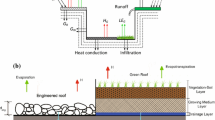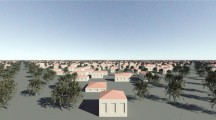Abstract
A multilayer one-dimensional canopy model was developed to analyze the relationship between urban warming and the increase in energy consumption in a big city. The canopy model, which consists of one-dimensional diffusion equations with a drag force, has three major parameters: building width, distance between buildings, and vertical floor density distribution, which is the distribution of a ratio of the number of the buildings that are taller than some level to all the buildings in the area under consideration. In addition, a simplified radiative process in the canopy is introduced. Both the drag force of the buildings and the radiative process depend on the floor density distribution. The thermal characteristics of an urban canopy including the effects of anthropogenic heat are very complicated. Therefore, the focus of this research is mainly on the basic performance of an urban canopy without anthropogenic heat. First, the basic thermal characteristics of the urban canopy alone were investigated. The canopy model was then connected with a three-dimensional mesoscale meteorological model, and on-line calculations were performed for 10 and 11 August, 2002 in Tokyo, Japan. The temperature near the ground surface at the bottom of the canopy was considerably improved by the calculation with the canopy model. However, a small difference remained between the calculation and the observation for minimum temperature. Deceleration of the wind was well reproduced for the velocity at the top of the building by the calculation with the canopy model, in which the floor density distribution was considered.
Similar content being viewed by others
References
M. Aida (1982) ArticleTitle‘Urban Albedo as a Function of the Urban Structure – A Model Experiment’ Boundary-Layer Meteorol. 23 405–413 Occurrence Handle10.1007/BF00116269
M. Aida K. Gotoh (1982) ArticleTitle‘Urban Albedo as a Function of the Urban Structure – A Two-dimensional Numerical Simulation’ Boundary-Layer Meteorol 23 415–424 Occurrence Handle10.1007/BF00116270
H. Akbari A. H. Rosenfeld H. Taha (1990) ArticleTitle‘Summer Heat Islands, Urban Trees, and White Surfaces’ ASHRAE Trans 96 1381–1388
Y. Ashie T. C. Vu T. Asaeda (1999) ArticleTitle‘Building a Canopy Model for the Analysis of Urban Climate’ J. Wind Eng. Ind. Aerodyn. 81 237–248 Occurrence Handle10.1016/S0167-6105(99)00020-3
A. K. Blackadar (1968) ArticleTitle‘The Vertical Distribution of Wind and Turbulent Exchange in Neutral Atmosphere’ J. Geophys. Res. 67 3085–3102
K. Gambo (1978) ArticleTitle‘Notes on the Turbulence Closure Model for Atmospheric Boundary Layers’ J. Meteorol. Soc. Jpn. 56 466–480
A. Hagishima J. Tanimoto T. Katayama (2001) ArticleTitle‘Experiment Study on the Validity of an Urban Canopy Model in and Above the Canopy Layer’ J. Archit. Plan. Environ. Eng. 548 31–37
T. Ichinose K. Shimodozono K. Hanaki (1999) ArticleTitle‘Impact of Anthropogenic Heat on Urban Climate in Tokyo’ Atmos. Environ. 33 3897–3909 Occurrence Handle10.1016/S1352-2310(99)00132-6
M. Inoue H. Kondo (1998) ArticleTitle‘A Study on the Effect of Anthropogenic Heat on the Temperature Distribution in the Urban Canopies’ J. Jpn. Soc. Atmos. Environ. 33 93–108
JMA: 2002, Outline of the Operational Numerical Weather Prediction at the Japan Meteorological Agency, Appendix to WMO Numerical Weather Prediction Progress Report, available from http://www.jma.go.jp/JMA_HP/jma/jma-eng/jma-center/nwp/outline-nwp/index.htm
W. Jurges (1924) ArticleTitle‘Der Warmeuberergang an einer ebenen Wand’ Gesundheight-Ingnierur 19 1
H. Kikegawa Y. Genchi H. Yoshikado H. Kondo (2003) ArticleTitle‘Development of a Numerical Simulation System Toward Comprehensive Assessments of Urban Warming Countermeasures, Including Their Impacts upon the Urban Building’s Energy-demands’ Appl. Energy 76 449–466 Occurrence Handle10.1016/S0306-2619(03)00009-6
J. Kondo (1975) ArticleTitle‘Air–sea Bulk Transfer Coefficients in Diabatic Conditions’ Boundary-Layer Meteorol. 9 91–124 Occurrence Handle10.1007/BF00232256
J. Kondo (Eds) (1994) The Meteorology in Water Environment Asakura-shoten Tokyo 350
J. Kondo S. Akashi (1976) ArticleTitle‘Numerical Studies on the Two-dimensional Flow in a Horizontally Homogeneous Canopy Layer’ Boundary-Layer Meteorol. 10 255–272 Occurrence Handle10.1007/BF00919389
Kondo, H.: 1989, Description of NRIPR Mesoscale Model, Technical Report No. 44, National Research Institute for Pollution and Resources, Tsukuba, Japan, 76 pp
H. Kondo (1995) ArticleTitle‘The Thermally Induced Local Wind and Surface Inversion over the Kanto plain On Calm Winter Nights’ J. Appl. Meteorol. 34 1439–1448 Occurrence Handle10.1175/1520-0450(1995)034<1439:TTILWA>2.0.CO;2
H. Kondo F. H. Liu (1998) ArticleTitle‘A Study on the Urban Thermal Environment Obtained Through a One-dimensional Urban Canopy Model’ J. Jpn. Soc. Atmos. Environ. 33 179–192
H. Kondo N. Saigusa S. Murayama S. Yamamoto A. Kannari (2001) ArticleTitle‘A Numerical Simulation of the Daily Variation of CO2 in the Central Part of Japan, Summer Case’ J. Meteorol. Soc. Jpn. 79 11–21 Occurrence Handle10.2151/jmsj.79.11
H. Kondo H. Kikegawa (2003) ArticleTitle‘Temperature Variation in the Urban Canopy with Anthropogenic Energy Use’ Pure Appl. Geophys. 160 317–324 Occurrence Handle10.1007/s00024-003-8780-9
H. Kusaka H. Kondo H. Kikegawa F. Kimura (2001) ArticleTitle‘A Simple Single-layer Urban Canopy Model for Atmospheric Models: Comparison with Multi-layer and Slab models’ Boundary-Layer Meteorol. 101 329–358 Occurrence Handle10.1023/A:1019207923078
W. H. McAdams (1954) Heat Transmission EditionNumber3 McGraw-Hill New York 532 pp
A. Martilli (2002) ArticleTitle‘Numerical Study of Urban Impact on Boundary Layer Structure: Sensitivity to Wind Speed, Urban Morphology, and Rural Soil Moisture’ J. Appl. Meteorol. 41 1247–1266 Occurrence Handle10.1175/1520-0450(2002)041<1247:NSOUIO>2.0.CO;2
A. Martilli A. Clippier M. W. Rotach (2002) ArticleTitle‘An Urban Surface Exchange Parameterization for Mesoscale Models’ Boundary-Layer Meteorol. 104 261–304 Occurrence Handle10.1023/A:1016099921195
T. Maruyama (1991) ArticleTitle‘Numerical Simulation of Turbulent Boundary Layer over Complicated Surfaces Such as Urban Areas’ J. Wind Eng. 47 81–81
V. Masson (2000) ArticleTitle‘A Physically-based Scheme for the Urban Energy Budget in Atmospheric Models’ Boundary-Layer Meteorol. 94 354–397 Occurrence Handle10.1023/A:1002463829265
Murakami, S., Mochida, A., Kim, S., Ooka, R., Yoshida, S., Kondo, H., Genchi, Y., and Shimada, A.: 2000, ‘Software Platform for the Total Analysis Wind Climate and Urban Heat Island. Integration of C.W.E. Simulation from Human Scale to Urban Scale, Proc 3rd International Symposium on Computational Wind Engineering, pp. 23–36
M. Nakanishi (2000) ArticleTitle‘Large-Eddy Simulation of Radiation Fog’ Boundary-Layer Meteorol. 94 461–493 Occurrence Handle10.1023/A:1002490423389
T. R. Oke (1978) Boundary Layer Climate Mathuen & Co. Ltd. New York 372 pp
Z. Sorbjan M. Uliasz (1982) ArticleTitle‘Some Numerical Urban Boundary-layer Studies’ Boundary-Layer Meteorol. 22 481–502 Occurrence Handle10.1007/BF00124707
I. Uno H. Ueda S. Wakamatsu (1989) ArticleTitle‘Numerical Modeling of the Nocturnal Urban Boundary Layer’ Boundary-Layer Meteorol. 49 77–98 Occurrence Handle10.1007/BF00116406
A. Urano T. Ichinose K. Hanaki (1999) ArticleTitle‘Thermal Environment Simulation for Three-dimensional Replacement of Urban Activity’ J Wind Eng. Ind. Aerodyn. 81 197–210 Occurrence Handle10.1016/S0167-6105(99)00017-3
T. C. Vu Y. Ashie T. Asaeda (2002) ArticleTitle‘A k–Turbulence Closure Model for the Atmospheric Boundary Layer including Urban Canopy’ Boundary-Layer Meteorol. 102 459–490 Occurrence Handle10.1023/A:1013878907309
T. Watanabe J. Kondo (1990) ArticleTitle‘The Influence of the Canopy Structure and Density upon the Mixing Length within and above Vegetation’ J Meteorol. Soc. Jpn. 68 227–235
Author information
Authors and Affiliations
Corresponding author
Rights and permissions
About this article
Cite this article
Kondo, H., Genchi, Y., Kikegawa, Y. et al. Development of a Multi-Layer Urban Canopy Model for the Analysis of Energy Consumption in a Big City: Structure of the Urban Canopy Model and its Basic Performance. Boundary-Layer Meteorol 116, 395–421 (2005). https://doi.org/10.1007/s10546-005-0905-5
Received:
Issue Date:
DOI: https://doi.org/10.1007/s10546-005-0905-5




